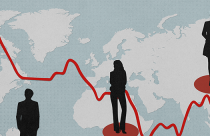Experts’ Take: Trends in Biomedical R&D Funding

Two recent papers on worldwide biomedical R&D spending have some good news and some bad news for researchers in the field. For researchers in Europe and North America the news is bad but for Asia the prospects have never looked better.
Europe and America: Funding Down
For the period 2007–2012 European investment in biomedical R&D was flat while in the US and Canada it decreased by about 2% per year. In the US, around 64 percent of all applied biomedical R&D funding comes from within the industry, while just 22 percent comes from the federal government. Since the US is by far the world’s largest player in this sort of research, with about half the total expenditures, the reasons for its decline in spending are of interest. Partly this is due to political infighting in the US Congress which paralyzes action on planning and funding research. But the government’s share of the research pie has not gone down; it has risen at a positive though anemic 0.8% per year. What has gone down is the private sector’s contribution. It seems that the biomedical industry is spending the same amount, but is spending more and more outside of the US, in Asia, where labor is cheap and regulations for drug development are fewer.
Asia: Funding up
Throughout Asia and Oceania, including Australia, biomedical funding is on the rise. Japan, the dominant player, has shown an annual funding increase of about 6% from 2007–2012, a level matched by Australia and India, and surpassed by South Korea. But by far the biggest increases have come in China, which had a relatively small level of funding before, but now boasts a whopping 33% yearly increase. If China continues to increase its funding at this torrid rate in nine years it will overtake the US as the world’s biggest biomedical R&D engine, going from a mere $6 billion (2012) to $109 billion (2021). Future extrapolations are risky, of course. China can’t maintain a growth rate of 33% indefinitely. Nevertheless, I believe that although the Chinese juggernaut will be slowed, it cannot be stopped. I’ve felt this way since I met some Chinese visiting professors while I was a graduate student back in the 1980s. They really impressed me with their competence and work ethic. “The Chinese are coming,” an American professor said admiringly. They are.
Implications for Researchers
If present trends continue, look to the east! That’s where an increasingly large proportion of cutting edge research will take place. It’s also where the ripest opportunities for collaboration will be. This will not be a smooth process: there will be ups and downs, fits and starts depending on local politics and world economic situations. But the US, with 5% of the world’s population, will not fund 50% of biomedical research forever. The rest of the world is catching up in quality of research and in funding levels. And this is good news.
Experts View on Biomedical R&D Funding
The longer we continue to favor short-term applied research projects over larger basic or pure research endeavors, the greater the likelihood that this global transition in research funding will continue.
PhD, Management Studies (30+ years of Operational Research and Academic Writing Experience, USA)
The increased growth of research spending outside of the US is just basic capital efficiency at work. Why spend money jumping through regulatory hoops and paying higher labor costs when you can run larger studies with less bureaucratic headaches for the same or less cost? This keeps the bean counters and shareholders happy, but at what cost? Rationalizing that “the end justifies the means” will last only as long as appropriate governance and oversight remains intact. As soon as corners get cut to hit lower cost numbers, the integrity of the collected data gets brought into question. Will we be able to maintain the research integrity to question such data before formal approval is granted?
We appear to be developing a predilection for treating R&D as a short-term cost-cutting target. In addition, the longer we continue to favor short-term applied research projects over larger basic or pure research endeavors, the greater the likelihood that this global transition in research funding will continue.
As an American academic, I see the almost minuscule rise in government funding for this research to be a mark of shame on our nation and especially on the U.S. Congress
PhD, American History (12+ years of Operational Research and Academic Writing Experience, USA)
While it is certainly beneficial that biomedical R&D is up in Asia, it doesn’t make up for the downward trend on expenditures in North America. North America, and especially the U.S., has the ability, as has been exercised in the past, to be the largest contributor to global biomedical research. As an American academic, I see the almost minuscule rise in government funding for this research to be a mark of shame on our nation and especially on the U.S. Congress. It is, as the article rightly points out, a product of political infighting, which of course is affecting not just the area in question, but many, many areas of scientific and cultural research and production in the U.S.
I see no reason to bemoan the advances in Asia – but I also see no reason to ignore the implications of lessened research in North America. All research is good research, in my eyes, and the more, the better. It impacts, most certainly and acutely, young scientists and their ability to sustain their potentially ground breaking work. An even bigger fear is that talented young scientists who are unable to find funding will leave the field all together. With less R & D and with potentially less talent in the field, the affects to world health and progress can only be negative. Americans, in particular, should be hounding their national representatives about this issue.
Currently, the US is the source leader for new drugs, medical devices and clinical procedures. Without the source for new drugs, the war against the growing antibiotic resistant viruses can be lost.
MS, Information Technology (11+ years of English-Japanese Translation experience, Japan)
University of Rochester Medical Center and Journal of American Medical Association both have published articles relating to US losing ground in the biomedical research arena. This can have implication on our future quality of life in the US.
Currently, the US is the source leader for new drugs, medical devices and clinical procedures. Without the source for new drugs, the war against the growing antibiotic resistant viruses can be lost. This type of loss can have major implications in hospitals all around the US with patients dying without any treatment options. Also, it would be difficult to combat the next outbreak such as the Ebola outbreak.
Each country has different challenges and priorities than the US. For example, the priority in Japan with a large aging population would be to have a new source of drugs to help stop, treat, and reverse Alzheimer’s and not new antibiotics. Therefore, the new drugs, medical devices, and clinical procedures that are sourced from the other countries may not be relevant for majority of the US citizens. This can have a direct impact on quality of life in the US.
Although robust evidence of efficacy is still lacking for many traditional medicines, superior longevity among Chinese and Japanese populations, to my mind, comprises a very fine piece of evidence, not to mention known use over thousands of years—an impossible and enviable validation for any new pharmaceutical.
PhD, Cancer (12+ years of Scientific and Medical Writing experience, AU)
Current Japanese and Chinese biomedical research outputs portray the upbeat atmosphere that the article “Trends in biomedical R&D funding” alludes to and are indicative of growing autonomy. As an economy, the US owes its resilience and preeminence to its strong pharmaceutical and technological footholds, which remain far from threatened by the east. Accordingly, however canny and verdant Asian biomedical efforts are, the US will protect its dominance over its own industry, which in some cases flogs new drugs that either lack efficacy or have only marginal and speculative advantages over decade old drug therapies. This blog may not be an appropriate forum for naming names, but the aggressive marketing and public opinion interventions performed by American pharmaceutical companies are no secret, and are justified in economic terms.
Where Asian business models may be largely compliant with dictates from the West, public opinions of health and medical interventions are, at the very least, strongly influenced by age-old traditional medicines. In many cases, these lack rigorous Western validation and concepts of active ingredients, repeatability, and concentration dependence diffuse quickly in muddy plant extracts and natural potions. Hence it is no surprise that much research is dedicated to identifying constituents of green tea, vinegars, and gingers to name a few, and to in vivo and clinical characterizations of their effects on health and disease, as pure extracts and whole traditional preparations. Herein may lie distinguishing features of Asian biomedical research that could ultimately lead to the decline of great Western pharmaceutical interests. Although robust evidence of efficacy is still lacking for many traditional medicines, superior longevity among Chinese and Japanese populations, to my mind, comprises a very fine piece of evidence, not to mention known use over thousands of years—an impossible and enviable validation for any new pharmaceutical. Thus, Kuhnian paradigm shifts may coincide with global economic developments over the coming decades, potentially contributing to better medicine and more homogeneous, global biomedical R&D funding.





 The longer we continue to favor short-term applied research projects over larger basic or pure research endeavors, the greater the likelihood that this global transition in research funding will continue.
The longer we continue to favor short-term applied research projects over larger basic or pure research endeavors, the greater the likelihood that this global transition in research funding will continue. As an American academic, I see the almost minuscule rise in government funding for this research to be a mark of shame on our nation and especially on the U.S. Congress
As an American academic, I see the almost minuscule rise in government funding for this research to be a mark of shame on our nation and especially on the U.S. Congress Currently, the US is the source leader for new drugs, medical devices and clinical procedures. Without the source for new drugs, the war against the growing antibiotic resistant viruses can be lost.
Currently, the US is the source leader for new drugs, medical devices and clinical procedures. Without the source for new drugs, the war against the growing antibiotic resistant viruses can be lost. Although robust evidence of efficacy is still lacking for many traditional medicines, superior longevity among Chinese and Japanese populations, to my mind, comprises a very fine piece of evidence, not to mention known use over thousands of years—an impossible and enviable validation for any new pharmaceutical.
Although robust evidence of efficacy is still lacking for many traditional medicines, superior longevity among Chinese and Japanese populations, to my mind, comprises a very fine piece of evidence, not to mention known use over thousands of years—an impossible and enviable validation for any new pharmaceutical. 



